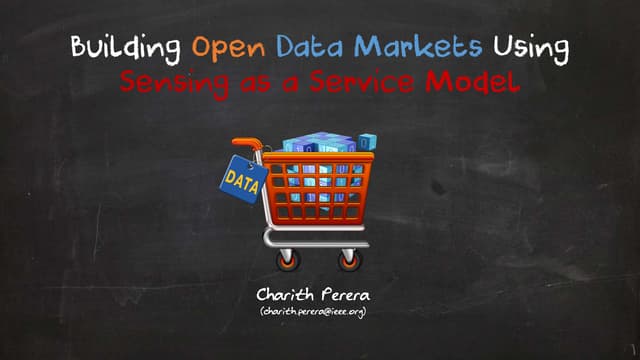Hacking Iot: Case Study on Baby Monitor Exposures and Vulnerabilities - Rapid7
Create your free account to read unlimited documents.
IOT-2016 7-9 Septermber, 2016, Stuttgart, Germany

You are reading a preview.
Create your free account to continue reading.
 1
1
Like this presentation? Why not share!
-
 Privacy Dynamics: Learning Privacy ... by Arosha Bandara 1122 views
Privacy Dynamics: Learning Privacy ... by Arosha Bandara 1122 views -
 Validation, Verification and Explan... by Arosha Bandara 2001 views
Validation, Verification and Explan... by Arosha Bandara 2001 views -
 SEAMS-2016, 16-17 May, 2016, Austin... by Charith Perera 1144 views
SEAMS-2016, 16-17 May, 2016, Austin... by Charith Perera 1144 views -
 Building Open Data Markets Using Se... by Charith Perera 1137 views
Building Open Data Markets Using Se... by Charith Perera 1137 views -
 WF-IOT-2014, Seoul, Korea, 06 March... by Charith Perera 2123 views
WF-IOT-2014, Seoul, Korea, 06 March... by Charith Perera 2123 views -
 IS-EUD-2015, Madrid, Spain, 27 May ... by Charith Perera 1459 views
IS-EUD-2015, Madrid, Spain, 27 May ... by Charith Perera 1459 views
Upcoming SlideShare
Privacy Dynamics: Learning Privacy Norms for Social Software
Download to read offline and view in fullscreen.
Sep. 12, 2016
1,843 views
IOT-2016 7-9 Septermber, 2016, Stuttgart, Germany
Sep. 12, 2016
1,843 views
Charith Perera, Ciaran Mccormick, Arosha Bandara, Blaine A. Price, Bashar Nuseibeh, Privacy-by-Design Framework for Assessing Internet of Things Applications and Platforms, Proceedings of the 6th ACM International Conference on Internet of Things (IoT), Stuttgart, Germany, November, 2016, Pages 83-92

Recommended
-

Privacy Dynamics: Learning Privacy Norms for Social Software
Arosha Bandara
-

Validation, Verification and Explanation in a Smarter World
Arosha Bandara
-

SEAMS-2016, 16-17 May, 2016, Austin, Texas, United States
Charith Perera
-

Building Open Data Markets Using Sensing as a Service Model
Charith Perera
-

WF-IOT-2014, Seoul, Korea, 06 March 2014
Charith Perera
-

IS-EUD-2015, Madrid, Spain, 27 May 2015
Charith Perera
-

PIMRC-2012, Sydney, Australia, 28 July, 2012
Charith Perera
-

SKG-2013, Beijing, China, 03 October 2013
Charith Perera
-

WF-IOT-2014, Seoul, Korea, 06 March 2014
Charith Perera
-

iThings-2012, Besançon, France, 20 November, 2012
Charith Perera
Related Books
Free with a 30 day trial from Scribd
See all
Related Audiobooks
Free with a 30 day trial from Scribd
See all
- 1 Like
- Statistics
- Notes
IOT-2016 7-9 Septermber, 2016, Stuttgart, Germany
- 1. Privacy-‐by-‐Design Framework for Assessing Internet of Things Applications and Platforms Charith Perera, Ciaran McCormick, Arosha K. Bandara, Blaine Price, Bashar Nuseibeh The 6th International Conference on the Internet of Things (IoT 2016) November 7–9, 2016 in Stuttgart, Germany.
- 2. Internet of Things • The Internet of Things (IoT) is "…the network of physical objects— devices, vehicles, buildings and other items—embedded with electronics, software, sensors, and network connectivity that enables these objects to collect and exchange data…"# • By 2020, there will be 50 to 100 billion devices (i.e. things, sensors, smart objects) connected to the Internet* # International Telecommunication Union, Internet of Things Global Standards Initiative, 2015, http://www.itu.int/en/ITU-‐T/gsi/iot/Pages/default.aspx * International Data Corporation (IDC) Corporate USA, "Worldwide smart connected device shipments," March 2012, http://www.idc.com/getdoc.jsp?containerId=prUS23398412
- 3. Application Development Desktop Application Mobile Application Web Application Application • Processing happens locally • UI sits locally • Processing happens locally complemented by cloud resources • UI sits locally • Processing happens remotely • UI sits locally
- 4. Internet of Things Application Development BeagleBone Waspmote Raspberry PiArdunio Gadgeteer Dragonboard 410C • NO Operating System • Less Powerful • OS Driven • More Powerful Cloud Computing • Unlimited Computational Resources*
- 5. Todays IoT Development Market Hardware Software
- 6. Privacy-‐by-‐Design • IoT applications are complex by nature as they involve both software and hardware as well as many different types of computational devices (e.g., sensors, gateways, cloud) • Privacy is a significant problem in IoT applications because they handle data that can be used to derive very sensitive personal information
- 7. Why hasn't privacy been a priority? • IoT systems (applications, service, platforms) are still new; Not mature enough • Most IoT platforms follow the philosophy "You feed your data to our platform, we do the processing and give you back the results" • Current IoT platform providers assume, anyone who uses their platform has the full ownership of the data they feed. (In reality this is not the case always) • Therefore, privacy is not a major concern for IoT platform providers.
- 8. Our Motivation and Proposed solution • There isn't any process/methodology/framework to help software architects in assessing and designing IoT applications • Existing frameworks are not prescriptive enough to follow by an engineer (We discuss them few slides later) • Recent Security and Privacy Violations: HACKING IoT: A Case Study on Baby Monitor Exposures and Vulnerabilities# • Therefore, we wanted to build a Privacy-‐by-‐design framework that can guide software architects in assessing IoT application. # https://www.rapid7.com/docs/Hacking-‐IoT-‐A-‐Case-‐Study-‐on-‐Baby-‐Monitor-‐Exposures-‐and-‐Vulnerabilities.pdf
- 9. BUT IT IS NOT …. • Guidelines SHOULD NOT be used to compare different IoT application or platforms. • The primary reason is that each IoT application or platforms is designed to serve a specific purpose or category of application. Focus: Enterprise middleware platform for Smart Cities and Businesses Focus: Smart Home Automation
- 10. What is out there ? (Literature) Privacy by Design Foundational Principles -‐ Ann Cavoukian* 1) Proactive not reactive; preventative not remedial 2) Privacy as the default setting 3) Privacy embedded into design 4) Full functionality positive-‐sum, not zero-‐sum 5) End-‐to-‐end security-‐full life-‐cycle protection 6) Visibility and transparency-‐ keep it open 7) Respect for user privacy, keep it user-‐centric *A. Cavoukian, "Resolution on privacy by design," in 32nd International Conference of Data Protection and Privacy Commissioners, 2010.
- 11. What is out there ? (Literature) LINDDUN – Deng et al.* *M. Deng, K. Wuyts, R. Scandariato, B. Preneel, and W. Joosen, "A privacy threat analysis framework: supporting the elicitation and fulfillment of privacy requirements," Requirements Engineering, vol. 16, no. 1, pp. 3–32, 2011. This is a privacy threat analysis framework that uses data flow diagrams (DFD) to identify privacy threats. 1) Define the DFD 2) Map privacy threats to DFD elements 3) Identify threat scenarios 4) Prioritize threats 5) Elicit mitigation strategies 6) Select corresponding PETS
- 12. What is out there ? (Literature) *J.-‐H. Hoepman, "Privacy Design Strategies," in ICT Systems Security and Privacy Protection, vol. 428, N. Cuppens-‐Boulahia, F. Cuppens, S. Jajodia, A. Abou El Kalam and T. Sans, Eds., Springer Berlin Heidelberg, 2014, pp. 446-‐459. Privacy Design Strategies –Hoepman* 1) Minimize 2) Hide 3) Separate 4) Aggregate 5) Inform 6) Control 7) Enforce 8) Demonstrate • We determined that Hoepman's is the most appropriate starting point for developing a more detailed privacy-‐by-‐design • Primarily because this framework already focuses on the architectural aspects of privacy design
- 13. IoT Data Flow View CDA DPP DPADS DD CDA DPP DPADS DD CDA DPP DPADS DD CDA DPP DPA DS DD Consent and Data Acquisition Data Pre-‐Processing Data Processing and Analysis Data Storage Data Dissemination
- 14. Privacy By Design Guidelines 1) Minimise data acquisition 2) Minimise number of data sources 3) Minimise raw data intake 4) Minimize knowledge discovery 5) Minimize data storage 6) Minimize data retention period 7) Hidden data routing 8) Data anonymization 9) Encrypted data communication 10) Encrypted data processing 11) Encrypted data storage 12) Reduce data granularity 13) Query answering 14) Repeated query blocking 15) Distributed data processing 16) Distributed data storage 17) Knowledge discovery based aggregation 18) Geography based aggregation 19) Chain aggregation 20) Time-Period based aggregation 21) Category based aggregation 22) Information Disclosure 23) Control 24) Logging 25) Auditing 26) Open Source 27) Data Flow Diagrams (DFD) 28) Certification 29) Standardization 30) Compliance with Policy, Law, Regulations MINIMISEHIDESEPARATE AGGREGATIONDEMONSTRATE INFORM CONTROL / ENFORCE
- 15. Evaluation of Privacy Capabilities: Methodology • Step 1: Identify how data flows in the existing application or platform • Step 2: Build a table for each node where columns represent data life cycle phases and rows represent each privacy-‐by-‐design guideline. • Step 3: Depending on the level of detail which software architects wish to explore, they can either use (1) a summarised colour coding base scheme (2) a notes based scheme
- 16. Evaluation of Privacy Capabilities: Methodology
- 17. Platforms We Assessed http://www.eclipse.org/smarthome/ https://github.com/OpenIotOrg/openiot • Focus: Enterprise middleware platform for Smart Cities and Businesses • Middleware infrastructure supports flexible configuration and deployment of algorithms for collecting, and filtering information streams stemming from internet connected objects • Focus: Smart Home Automation • Platform for integrating different home automation systems and technologies into one single solution that allows over-‐ arching automation rules and uniform user interfaces
- 18. Results
- 19. Research Directions • Can 1) Novice 2) Experience Software architects assess a given platform using the proposed guidelines consistently? If there are variation, why? • Given a case study, can privacy guidelines guide 1) Novice 2) Experience Towards a better privacy-‐aware IoT applications Evaluation Future work • Privacy Tactics -‐ Tactics are design decisions that improve individual quality attribute (e.g. Privacy) concerns. [Basic building blocks] • Privacy Patterns -‐ Patterns describe the high-‐level structure and behaviour of software systems as the solution to multiple system requirements [Complex Compositions]
- 20. Thank You
Hacking Iot: Case Study on Baby Monitor Exposures and Vulnerabilities - Rapid7
Source: https://www.slideshare.net/ngcharithperera/privacybydesignframework-for-assessinginternet-of-things-applications-and-platforms

0 Response to "Hacking Iot: Case Study on Baby Monitor Exposures and Vulnerabilities - Rapid7"
Post a Comment